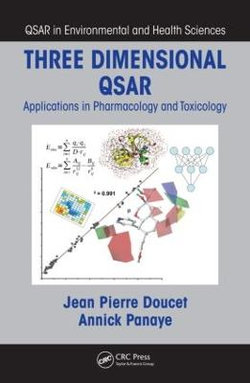As a result of new statistical and mathematical approaches, improved visualization tools, and recognition by international regulatory groups, quantitative structure-activity relationships (QSARs) now play important roles in pharmacology for the design of new drugs as well as in toxicology and ecotoxicology for hazard identification and risk assessment. Providing up-to-date coverage of the field, Three Dimensional QSAR: Applications in Pharmacology and Toxicology presents the most recent QSAR methods and illustrates their scope, advantages, and limitations. Part I The first part of the book addresses CoMFA and related methods, such as CoMSIA, FLUFF, SOMFA. It also describes shape-, surface-, and volume-based approaches, including MSA, excluded volume, LIV, HASL, receptor surface model, COMPASS, and CoMSA. Part II Focusing on methods that use 3D information, the second part covers autocorrelation methods, such as GRIND; similarity-based methods, including similarity matrices and quantum similarity indices; and quantitative spectroscopic data--activity relationships. Some applications in data mining are also explored. Part III The third part deals with post-3D models.
The authors discuss the adaptation of the receptor and simultaneous presence of several conformers or solvation mechanisms. Part IV The final part presents receptor-related approaches as well as docking and free energy calculations, which are treated at various levels. This part concerns the extensive sampling of phase space and approximate methods, such as linear interaction energy, Poisson--Boltzmann, and generalized Born models. A case study covering several parallel approaches is also developed. An appendix offers the basic principles of modeling and statistical tools routinely required in QSAR methodologies, including optimization methods, molecular mechanics and dynamics, multivariate analysis, nonlinear models, and evolutionary techniques. It provides newcomers with the concepts necessary to fully grasp the essentials of these methods and gives a basic grounding in their correct use. Illustrated with numerous examples and a color insert, this book supplies a clear overview of the strengths and weaknesses of 3D-QSAR approaches.
It explains how these modern techniques can link the biological activity of chemicals to their structure, encompassing both their 2D structural formulae and 3D geometry.
- ISBN:
- 9781420091151
- 9781420091151
-
Category:
- Pharmaceutical technology
- Format:
- Hardback
- Publication Date:
-
17-12-2010
- Language:
- English
- Publisher:
- Taylor & Francis Inc
- Country of origin:
- United States
- Pages:
- 576
- Dimensions (mm):
- 234x156x36mm
- Weight:
- 1.23kg
This title is in stock with our overseas supplier and should arrive at our Sydney warehouse within 2 - 3 weeks of you placing an order.
Once received into our warehouse we will despatch it to you with a Shipping Notification which includes online tracking.
Please check the estimated delivery times below for your region, for after your order is despatched from our warehouse:
ACT Metro: 2 working days
NSW Metro: 2 working days
NSW Rural: 2-3 working days
NSW Remote: 2-5 working days
NT Metro: 3-6 working days
NT Remote: 4-10 working days
QLD Metro: 2-4 working days
QLD Rural: 2-5 working days
QLD Remote: 2-7 working days
SA Metro: 2-5 working days
SA Rural: 3-6 working days
SA Remote: 3-7 working days
TAS Metro: 3-6 working days
TAS Rural: 3-6 working days
VIC Metro: 2-3 working days
VIC Rural: 2-4 working days
VIC Remote: 2-5 working days
WA Metro: 3-6 working days
WA Rural: 4-8 working days
WA Remote: 4-12 working days




Share This Book: